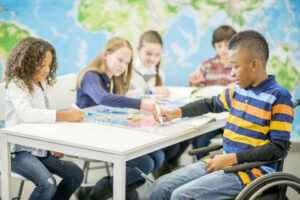Introduction
Inclusive practice in the early years can be defined as the belief that all children, regardless of their abilities or background, should participate in early years education. Developing such an inclusive ethos is vital to ensure that all children are valued within their learning environment.

This blog will explore five principles and the implementation of inclusive practice in early years settings, highlighting its significance in fostering learning and success during a child’s early education.
Understanding Inclusive Practice
In early years education, inclusive practice ensures that every child, regardless of their abilities or background, can fully participate and thrive. It encompasses a range of strategies aimed at meeting children’s diverse needs and preferences. A practice is considered inclusive if it adheres to these core principles: flexibility, placing each learner at the centre, and actively removing barriers to participation.
The philosophy underpinning inclusive practice asserts that every individual deserves a high-quality education tailored to their unique needs and personalities. This approach aims to shift from traditional expectations to broader societal expectations of community relationships. Values such as empathy, patience, and a commitment to social justice are integral, fostering an environment where children feel valued. This inclusive approach empowers children to embrace new situations and challenges, such as having peers with special educational needs in a mainstream classroom, without the apprehension that hindered their learning and self-actualisation.
Importance of Inclusive Practice in Early Years
Inclusive practice in early years settings offers numerous advantages. By bringing children of different abilities together, it enables them to interact with a diverse group, fostering friendships and an appreciation for various skills and talents. Exposure to differing perspectives also enhances tolerance and respect for differences among children. For those with special educational needs (SEN), accessible environments ensure they can participate fully in activities, boosting their confidence and potential.
Inclusive practice also benefits teachers and families. Educators develop a broader range of skills and practices, including better differentiation techniques, enhancing their teaching effectiveness. Families gain assurance knowing their children will receive support, strengthening home-school partnerships and improving communication.
The long-term societal benefits are profound: individuals raised in inclusive environments are more likely to contribute to inclusive societies. This fosters stronger social bonds, reduces discrimination, and promotes equal opportunities in communities and workplaces, regardless of individuals’ abilities or backgrounds.
Key Principles of Inclusive Practice
In early childhood education, inclusive practice ensures every child thrives by promoting equality, celebrating diversity, and fostering active engagement. It prioritizes a child-centred approach, tailoring learning to individual needs and encouraging participation, creating an inclusive environment where all children feel valued and supported.
Equality and Diversity
Promoting equality in early years settings ensures that all children have equal rights to access high-quality educational opportunities, regardless of their characteristics or differences. This involves implementing policies and practices that actively discourage discrimination and bias, in accordance with anti-discrimination legislation. Early years educators play a crucial role as role models of inclusive behaviour, employing fair and impartial strategies to set high expectations for every child.
Valuing and celebrating diversity is integral to inclusive practice. This entails recognizing and appreciating differences in backgrounds, cultures, abilities, and more, and ensuring that activities and curricula reflect this diversity. It also means providing children with a broad and inclusive view of the world through exposure to cultural and religious celebrations and diverse materials. Early years settings should incorporate diverse books, stories, songs, and activities that are both modelled and respected.

Participation and Engagement
The core of inclusive practice lies in enabling every child to participate fully. For instance, modifications like adding braille to a mural ensure that no child is excluded from active engagement in activities. Various barriers, such as physical access to materials or different learning styles, may exist. It is the teacher’s and school’s responsibility to adapt activities, materials, or instructions to overcome these barriers and facilitate participation. Providing flexible seating arrangements is an effective way to support children with diverse physical requirements. Additionally, materials can be modified; for instance, in activities involving pictures or models, a mural can be specially adapted to include braille.
Engaging children and families in this learning process is crucial. By fostering family engagement, educators invite families to share insights into their children’s strengths and needs. Building strong relationships with families through encouragement and regular communication enhances this partnership, supporting children’s learning and development both at home and in early years settings.
Child-Centered Approach
A child-centred approach prioritises the unique needs and learning styles of individual children. This acknowledges that children possess a diverse range of abilities, interests, and specific needs. Each child has strengths to nurture and areas where additional support and developmental focus are beneficial. Real-world learning breaks away from traditional student-teacher roles found in classrooms. Students acquire social skills through activities like public speaking, class discussions, and group tasks. They also learn responsibility by managing their time and actively participating in their learning journey. Teachers adopt a supportive role, guiding rather than dictating knowledge. Crafting engaging learning experiences tailored to each student involves keen observation, understanding their developmental stage and interests, and designing lessons accordingly. Learner-led topics and activities form the core of this approach, supported by educational theories and structured lesson plans. Active learning fosters initiative and self-motivation; portfolios document progress and achievements; differentiated teaching meets individual learning needs; field trips enrich learning with real-world experiences; and community involvement connects children with diverse perspectives, including grandparents, filmmakers, and artists.
Respecting a child’s unique abilities and empowering their voice means providing space for self-expression and encouraging responsibility for their own learning choices. Genuine choices and encouragement for their ideas and learning styles are pivotal. Similarly, respecting each child’s background recognises their heritage and encourages educators to value the cultural richness each child brings to their environment.
Legal and Policy Framework of Inclusive Practice
In early years education, inclusive practice is guided by laws such as the Equality Act 2010 and the Children and Families Act 2014, ensuring equal access and support for children with special educational needs. Local authorities provide crucial funding, guidance, and training to help settings implement inclusive approaches effectively. Collaborating closely with local authorities is essential for creating supportive learning environments tailored to each child’s needs and backgrounds.
Overview of Relevant Legislation
The Equality Act 2010 stands as a cornerstone of inclusive practice in early years education, outlining protections and ensuring equal opportunities for individuals. It prohibits discrimination based on characteristics such as disability, race, and gender, ensuring all children, regardless of background, have equitable access to education.
Further bolstering inclusive practice is the Children and Families Act (2014), which prioritizes services for children with special educational needs and disabilities (SEND). This legislation underscores the importance of involving the child and their parent/carer in decision-making processes and mandates local authorities to coordinate educational, health, and care services effectively.
National and Local Policies
The Early Years Foundation Stage (EYFS) guidelines shape the curriculum for children from birth to five years old, addressing their developmental needs. It values inclusive practice by ensuring:
- Providing a safe and inclusive environment for children to explore and develop their unique potential.
- Personalising learning to meet each child’s needs.
- Promoting the optimal levels of health, wellbeing, learning, and development for every child.
- Recognising each child’s unique family, cultural, and linguistic context and considering these factors in their progress assessments within the EYFS.
To facilitate inclusive practice, local authority guidelines and support are crucial. Local authorities offer funding, professional development opportunities, and other resources to early years settings. This may include funding for specialist equipment, access to specialized services, or guidance on best practices. Collaborating with local authorities ensures that early years settings receive the necessary support to establish inclusive environments effectively.
Strategies for Implementing Inclusive Practice
Implementing inclusive practices in education involves tailored instruction and ongoing professional development. Training focuses on differentiation, effective communication, and inclusive classroom design. Collaborative staff development fosters a supportive environment where educators share knowledge and plan strategies to support all students.

Creating an Inclusive Environment
Ensuring that classrooms are inclusive and accessible starts with creating a welcoming and considerate organisational structure. Firstly, the physical environment must comply with health and safety regulations, ensuring the removal of immediate threats such as sharp objects or hot items. For instance, classroom materials should be easily accessible and engaging for all children. Tables and equipment should be positioned so that every child, regardless of challenges, can access resources without obstacles. All areas within the classroom should be navigable to facilitate children’s movement and participation in physical activities. Adjusting furniture layouts may be necessary to accommodate those with movement or physical difficulties, such as replacing wooden benches with soft upholstered sofas or chairs. Sensory spaces are crucial and should be accessible to all children for full engagement in self-regulation activities. Provide adaptive equipment like cushions, adapted scissors, or movable tables to facilitate access to activities.
The next step is to offer inclusive materials and resources, such as books, toys, and learning materials representing diverse cultural backgrounds, abilities, and experiences. Inclusive resources help children see themselves and others positively, develop empathy, and learn the importance of respecting diverse populations. Include multiple formats (e.g., visuals, audio, tactile resources) to meet diverse learning needs and preferences effectively.
Differentiated Instruction
When teaching in differentiated ways, educators consider how they can modify the instructional experience to meet the diverse needs of children. Differentiated teaching often requires teachers to be flexible and responsive, as instruction may vary for different groups of children within the class simultaneously – using more hands-on activities for one group while providing visual, auditory, or graphic organizational tools for another.
Individual Learning Plans (ILPs) can be highly effective in planning instruction to meet children’s unique learning needs. Although each ILP will vary according to the needs of the child, generally, it will outline specific learning goals, the approach to be used, and the nature of the support to be provided. These personalized plans are developed in consultation with children’s families and other professionals who may have insights into their needs, such as speech-language therapists. ILPs should be reviewed regularly with children and their families to ensure that the learning goals and support remain appropriate.
Professional Development and Training
Professional development and training are crucial for implementing effective inclusive pedagogy. Districts and educators can offer training programs on using differentiation to support diverse learners, communicating effectively with parents and community members, and designing inclusive classroom environments, among other topics. Learning doesn’t stop after completing a training series; it’s an ongoing process that keeps educators updated on how to fully support all children through active learning opportunities aligned with best practices.
Building a knowledgeable and committed staff team is also vital. Creating opportunities for collaboration and knowledge-sharing among staff members can foster the development of robust inclusive practices, where colleagues learn from each other and collaboratively develop goals and plans. Mentoring, peer observations, and team meetings are examples of such opportunities.
Learn more about Effective Techniques for Child Supervision
Overcoming Challenges in Inclusive Practice
Overcoming challenges in inclusive practice involves identifying barriers such as physical access and limited resources, and addressing them through staff training, environmental adaptations, and strategic resource management. Supporting children with SEN requires close collaboration with parents and ongoing monitoring of their development. Efficiently managing resources involves creativity, leveraging donations, pursuing grants, and fostering partnerships for additional support.

Identifying and Addressing Barriers
Identifying barriers to inclusive practice is essential when implementing it, particularly concerning physical access and resource availability. This process starts with regular assessments of the environment and practices, followed by defining strategies to minimize inclusion barriers. For instance, staff might need training, new environmental resources, or physical adaptations to overcome these challenges.
Supporting Children with Special Educational Needs (SEN)
Working with children with SEN requires not just hard work but also organisation and collaboration. Early intervention with children with SEN offers them the best chance of receiving timely support. Teachers, especially SENCOs, should regularly monitor and assess children’s development and learning, collaborating closely with parents and carers to ensure consistent tracking.
Collaborating with these professionals and families will enhance support for the child and involve them in decision-making processes. This collaborative approach helps families plan support and empowers them to participate effectively.
Managing Limited Resources
Limited resources often present challenges in delivering inclusive practice. Maximising the effectiveness of our resources requires creativity and skill. It involves designing and producing educational materials using available resources and repurposing items daily to achieve educational goals. Sharing resources between classrooms, making greater use of school donations, and aligning with local authority priorities through grants and competitive bids are also crucial. Seeking funding from the private sector, through both delivered and donated resources, and fostering partnerships with local and international NGOs further enhances access to additional support.
Exploring external resources and support is essential. Numerous organisations and foundations offer grants and funding for projects aimed at enhancing inclusive education. Applying for such funds can provide the necessary resources. Additionally, local authorities and educational agencies often have programmes and funding available for specific types of inclusive education initiatives.
Case Studies and Examples of Inclusive Practice
Case studies and examples of inclusive practice illustrate successful implementation in educational settings. They include testimonials from educators and families, highlighting how these practices benefit children’s development and support families. These stories inspire others by offering practical insights and strategies for overcoming challenges in early years education.

Successful Implementation of Inclusive Practice
Practical examples demonstrate how best practices in inclusive nurseries can be implemented. For instance, one nursery achieved full accessibility by installing ramps and renovating rooms, while also using varied materials and adapting teaching methods to meet individual needs. This serves as a model for others, showing concrete examples of effective inclusive practices in action. Highlighting such examples provides evidence of their impact on children and offers valuable lessons and best practice tips. For example, showcasing how colour coding differentiated areas within their environment made it accessible for all children. By sharing success stories like these, nurseries can overcome challenges, involve families more effectively, and build confidence in their ability to promote inclusion.
Testimonials from Educators and Families
Educators can share personal testimonials of their experience with inclusive practice – how these practices have expanded their role as teachers and how they’ve potentially changed the children and families. They can share insights into how inclusive practices have helped their children develop or learn, and how it’s made a difference for their child and the family. Including stories of those who participate in inclusive practices amplifies the benefits possible and keeps this approach central for sharing and consideration by others. At the same time, hearing from these individuals provides encouragement and motivation for other educators and families to advocate for and implement inclusive practices in their settings.
Conclusion
Educators must strive to achieve inclusive practice in the early years. Upholding international laws to protect children’s rights not only ensures their rights but also fosters a fair and harmonious society conducive to democracy. Every educator must adopt new and appropriate strategies for implementing inclusion based on well-defined legal frameworks and principles. By overcoming challenges and studying exemplary cases, early years educators can effectively implement inclusive strategies. Inclusivity holds significant importance for children and their families in the early years and for their future.
